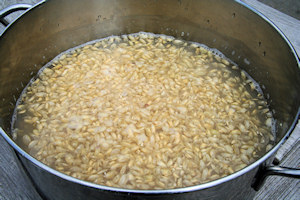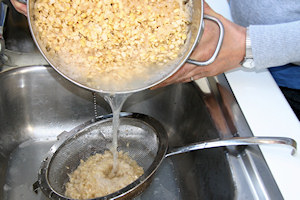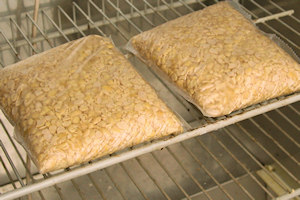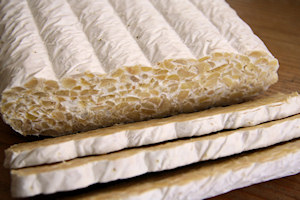Soybeans make the best tempeh: highest protein content (20%, same as meat), lots of white mycelium, firm texture and nice fruity smell and taste. However, at the bottom of this page you can find links to pages with instructions for making non-soy tempeh.
Make soybean tempeh
Making soybean tempeh at home is easy. All you need are soybeans, tempeh starter culture, and a bit vinegar. And of course you need a warm place of about 30°C to ferment the tempeh. If you have a grain mill, it will make your job a little bit easier. If you don’t have a grain mill, you will have to split the soybeans by hand. Let’s go over the instructions for making tempeh, step-by-step.
1. If your objective is to make 1 kg of tempeh, you will need to have the following ingredients:
- 600 g dry soybeans
- 5 Tbsp vinegar
- 1 tsp (about 3 to 5 grams) tempeh starter.

2. Take the dried soybeans and run them through a grain mill. The Family Grain Mill and the Porkert Universal Grain Mill are two examples of grain mills that will work just fine. If you don’t have access to a grain mill, or if you can’t purchase dehulled soybeans, then you will have to split the whole soybeans by hand after soaking.

3. You will need to soak the beans in a plenty of amount of water for 8 hours, if you’re using split soybeans. If you’re using whole soybeans you will have to soak them for 12 hours and then split them with a kneading motion.

4. Get rid of all the hulls by pouring the water through a strainer. Pour in some fresh water and repeat that until the majority of the hulls are removed. It’s not really an issue if a couple of the hulls remain. Some cooks do try to make tempeh without taking out the hulls. However, all the beans have to be split.

5. Transfer all the soybeans into a cooking pot and cover them with water. Pour the vinegar in, and cook it for about 30 minutes. The remaining hulls will gradually come up to the surface, and you can scoop them off.

6. Drain the water into a big colander and then put the beans back in the cooking pot.

7. Dry the beans by keeping the heat on when they’re in the cooking pot, but just use a medium heat setting for a couple of minutes until the soybeans are dry. This whole process only works if you make a very tiny batch of tempeh, up to 2 kg. If you make large amounts of tempeh, you have to dry the soybeans on a big, clean towl or even run them through a centrifuge. The factories that make tempeh run them through a centrifuge, for example.

8. Let the soybeans cool to below body temperature. Sprinkle the soybeans with the tempeh starter and mix them with a clean spoon for a good minute to distribute the tempeh starter culture evenly throughout the whole soybean mass. It is imperative to distribute the tempeh starter culture evenly.

9. Get two plastic bags that are about 18 x 27 cm (7-10 inches) and perforate them with a thick needle to make big holes that are about 15-20 mm apart (0.6-0.8 inches).

10. Divide up the soybeans into the two bags and seal them off. Press them until they are flat, to about a thickness of 4 cm (1.5 inches).

11. Put the bags in a warm place with a temperature of about 28-32 °C (82-90 °F) for about 36-48 hours, or until all the soybeans are covered with a very dense white mycelium. Try to keep the temperature at the lower end of the range as the time wears on.

12. Your tempeh should be ready now, and all your hard work will have paid off. Enjoy your delicious and fresh tempeh. Once you get the process nailed down, it will become easier and easier to make it. It will taste much better than store-bought tempeh.

Make non-soy tempeh
Unfortunately, social media has given soybeans a bad name. Soybeans are typically high in protein, fibre, vitamins, minerals and antioxidants. They also contain soya isoflavones, which are thought to have a range of health benefits. If you buy organic soybeans, you can be sure that they are GMO-free and contain no pesticides. However, if you are allergic to soy, you can make tempeh from other beans, such as black beans, green Dupuis lentils or chickpeas. An advantage of using these substitutes is that you don’t have to peel them. This saves time.
Below are links to instructions on how to make soy-free tempeh:
